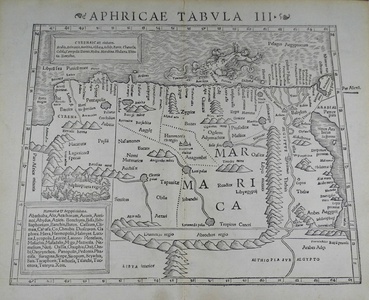| Method | Woodcut |
| Artist | Münster, Sebastian |
| Published | [Basel, 1552] |
| Dimensions | 255 x 340 mm |
| Notes |
A map of North Africa and Egypt, from Munster's 1552 edition of Ptolemy's Geographia. The region is rendered in impressive detail, and the map features a large decorative illustration of a sea-monster attacking a man off the coast of Marmarica. To the left, the cities of the Pentapolis are listed, with Cyrene represented as a small city. Likewise the Nile is rendered with a considerable knowledge of place names, including Thebes, Ptolemais, Arsinoe, Memphis, Babylon (Cairo), Tanis, Bubastis, Pelusium, Canopus, and Alexandria. The space between Cyrenaica and Egypt is less well represented, but still features numerous place names, mountain ranges, and tribal regions. Two box cartouches to the top and bottom left of the map provide Cyrenaic and Egyptian place names of unknown location. The map is presented in a trapezoidal border, and the verso, featuring descriptive text in Latin, has an elaborate border of architectural details, ribbons, cherubs, and a vignette of a supine bishop. Ptolemy (c. AD 100-170) was a Greek native of the Egyptian city of Alexandria, and a Roman citizen. Little is known about his life, but he is credited as the author of numerous works of mathematics, engineering, astronomy, astrology, philosophy, and geography. His most famous works were the Almagest, the Geography, and the Tetrabiblion, a triad that essentially formed the basis of Byzantine, Arabic, and European science for the next thousand years. The Geography in particular had a very long reach, being reprinted numerous times in the fifteenth and sixteenth centuries. Its most famous advocate was Columbus, who used a manuscript of the Geography to plot his western course for Asia, in the journey that resulted in the discovery of America. The work was also a major inspiration, and cartographic resource, for Munster, Mercator, and Ortelius. Sebastian Münster (20th January 1488 - 26th May 1552) was a German cartographer, cosmographer, and theologian. A gifted scholar of Hebraic, Münster originally joined the Franciscans, but left the order in favour of the Lutheran Church. He was appointed to the University of Basel in 1529, and published a number of works in Latin, Greek, and Hebrew. His most celebrated works are his Latin edition of Ptolemy's Geographia in 1540, and the Cosmographia in 1544. The Cosmographia was the earliest German description of the world, an ambitious work of 6 volumes published in numerous editions in German, Latin, French, Italian, and Czech. Condition: Central vertical fold as issued. Minor time toning and small tear to top of central fold, not affecting image. Time toning to edges of sheet. |
| Framing | unmounted |
| Price | £400.00 |
| Stock ID | 41449 |

